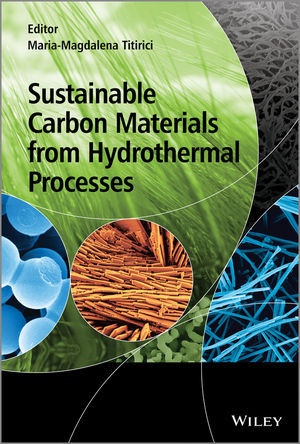Ulteriori informazioni
Informationen zum Autor Dr. Maria-Magdalena Titirici, Max-Planck Institute of Colloids and Interfaces, Germany Maria-Magdalena has been working in the field of hydrothermal carbonization (HTC) since 2005. Her laboratory at the Max-Planck Institute of Colloids and Interfaces has been driving the renewed interest in HTC for the production of high-tech carbonaceous materials. Since 2005 she has published more than 40 scientific papers on this topic, including 2 reviews, as well as a book chapter. Klappentext The production of low cost and environmentally friendly high performing carbon materials is crucial for a sustainable future. Sustainable Carbon Materials from Hydrothermal Processes describes a sustainable and alternative technique to produce carbon from biomass in water at low temperatures, a process known as Hydrothermal Carbonization (HTC).Sustainable Carbon Materials from Hydrothermal Processes presents an overview of this new and rapidly developing field, discussing various synthetic approaches, characterization of the final products, and modern fields of application for of sustainable carbon materials.Topics covered include:* Green carbon materials* Porous hydrothermal carbons* HTC for the production of valuable carbon hybrid materials* Functionalization of hydrothermal carbon materials* Characterization of HTC materials* Applications of HTC in modern nanotechnology: Energy storage, electrocatalysis in fuel cells, photocatalysis, gas storage, water purification, sensors, bioapplications* Environmental applications of HTC technology: Biochar production, carbon sequestration, and waste conversion* Scale-up in HTCSustainable Carbon Materials from Hydrothermal Processes will serve as a comprehensive guide for students and newcomers in the field, as well as providing a valuable source of information for researchers and investors looking for alternative technologies to convert biomass into useful products. Zusammenfassung This book will discuss hydrothermal carbonization (HTC) for the production of sustainable, versatile and functional carbonaceous materials. Inhaltsverzeichnis List of Contributors xi Preface xiii 1 Green Carbon 1 Maria-Magdalena Titirici 1.1 Introduction 1 1.2 Green Carbon Materials 3 1.2.1 CNTs and Graphitic Nanostructures 4 1.2.2 Graphene, Graphene Oxide, and Highly Reduced Graphene Oxide 11 1.2.3 Activated Carbons 14 1.2.4 Starbons 14 1.2.5 Use of Ionic Liquids in the Synthesis of Carbon Materials 19 1.2.6 HTC 27 1.3 Brief History of HTC 27 References 30 2 Porous Hydrothermal Carbons 37 Robin J. White, Tim-Patrick Fellinger, Shiori Kubo, Nicolas Brun, and Maria-Magdalena Titirici 2.1 Introduction 37 2.2 Templating - An Opportunity for Pore Morphology Control 39 2.2.1 Hard Templating in HTC 40 2.2.2 Soft Templating in HTC 42 2.2.3 Naturally Inspired Systems: Use of Natural Templates 49 2.3 Carbon Aerogels 50 2.3.1 Ovalbumin/Glucose-Derived HTC-Derived Carbogels 52 2.3.2 Borax-Mediated Formation of HTC-Derived Carbogels from Glucose 56 2.3.3 Carbogels from the Hydrothermal Treatment of Sugar and Phenolic Compounds 63 2.3.4 Emulsion-Templated "Carbo-HIPEs" from the Hydrothermal Treatment of Sugar Derivatives and Phenolic Compounds 65 2.4 Summary and Outlook 69 References 70 3 Porous Biomass-Derived Carbons: Activated Carbons 75 Dolores Lozano-Castello, Juan Pablo Marco-Lozar, Camillo Falco, Maria-Magdalena Titirici, and Diego Cazorla-Amoros 3.1 Introduction to Activated Carbons 75 3.2 Chemical Activation of Lignocellulosic Materials 77 3.2.1 H3PO4 Activation of Lignocellulosic Precursors 78 3.2.2 ZnCl2 Activation of Lignocellulosic Precursors 82 3.2.3 KOH and NaOH Activation of Lignocellulosic Precursors 84

